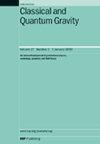从量子几何角度看量子条件曲率的起源
IF 3.6
3区 物理与天体物理
Q2 ASTRONOMY & ASTROPHYSICS
引用次数: 0
摘要
引力场(包括度量场)的量子化问题已通过环量子引力、量子场论和弦理论等多种方法进行了研究。然而,要解决将广义相对论(GR)和量子力学(QM)这两种根本不同的理论融合在一起的难题,另一种策略是采用量子几何方法。这种方法需要将量子力学扩展到相对论能量和有限引力场,同时将连续黎曼几何扩展到离散化(量子化)的芬斯勒-汉密尔顿几何。采用这种方法,也许可以弥合 GR 与 QM 之间的差距,甚至实现它们的统一。由此产生的基本张量似乎融合了其原有的经典和量子特性,有效地整合了量子力学对仿射连接和时空曲率的修正。我们的研究主要侧重于研究爱因斯坦-吉尔伯特-斯特劳斯公设背景下的里奇曲率张量。通过采用分析和数值方法,我们发现了量子条件曲率(QCC),它是引力的额外来源。这些 QCC 与爱因斯坦伽利略描述的传统曲率有着本质区别。大多数区域的利玛窦曲率主要为正,而量子化利玛窦曲率则显示为负。我们的结论是:QCC(a)具有内在的、本质的和真实的特性;(b)不应因其显著的量级而被忽视;(c)与经典 GR 中的曲率有本质区别。此外,我们还得出结论,所提出的量子几何方法可以为理解量子引力的出现提供另一种数学框架。本文章由计算机程序翻译,如有差异,请以英文原文为准。
Quantum geometric perspective on the origin of quantum-conditioned curvatures
The quantization of the gravitational field, which includes the metric field, has been investigated using various methods such as loop quantum gravity, quantum field theory, and string theory. Nevertheless, an alternative strategy to tackle the challenge of merging the fundamentally different theories of general relativity (GR) and quantum mechanics (QM) is through a quantum geometric approach. This particular approach entails extending QM to relativistic energies and finite gravitational fields, while also expanding the continuous Riemann to a discretized (quantized) Finsler–Hamilton geometry. By embracing this method, it may be feasible to bridge the gap between GR and QM or even achieve their unification. The resulting fundamental tensor appears to blend its original classical and quantum characteristics, effectively integrating quantum-mechanically induced revisions to the affine connections and spacetime curvatures. Our study primarily focuses on investigating the Ricci curvature tensor in the context of the Einstein–Gilbert–Straus metric. By employing both analytical and numerical methods, we have identified quantum-conditioned curvatures (QCC) that act as additional sources of gravitation. These QCC exhibit a fundamental difference from the traditional curvatures described by Einsteinian GR. While the Ricci curvatures are predominantly positive across most regions, the quantized Ricci curvatures display negativity. We conclude that the QCC (a) possess an intrinsic, essential, and real character, (b) should not be disregarded due to their significant magnitude, and (c) are fundamentally different from the curvatures found in classical GR. Moreover, we conclude that the proposed quantum geometric approach may offer an alternative mathematical framework for understanding the emergence of quantum gravity.
求助全文
通过发布文献求助,成功后即可免费获取论文全文。
去求助
来源期刊

Classical and Quantum Gravity
物理-天文与天体物理
CiteScore
7.00
自引率
8.60%
发文量
301
审稿时长
2-4 weeks
期刊介绍:
Classical and Quantum Gravity is an established journal for physicists, mathematicians and cosmologists in the fields of gravitation and the theory of spacetime. The journal is now the acknowledged world leader in classical relativity and all areas of quantum gravity.
 求助内容:
求助内容: 应助结果提醒方式:
应助结果提醒方式:


